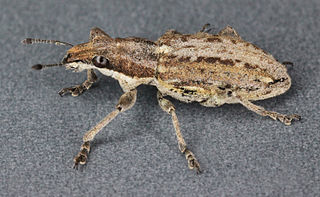
The Curculionidae are a family of weevils, commonly called snout beetles or true weevils. They are one of the largest animal families with 6,800 genera and 83,000 species described worldwide. They are the sister group to the family Brentidae.

Weevils are beetles belonging to the superfamily Curculionoidea, known for their elongated snouts. They are usually small – less than 6 mm in length – and herbivorous. Approximately 97,000 species of weevils are known. They belong to several families, with most of them in the family Curculionidae. It also includes bark beetles, which while morphologically dissimilar to other weevils in lacking the distinctive snout, is a subfamily of Curculionidae. Some other beetles, although not closely related, bear the name "weevil", such as the biscuit weevil, which belongs to the family Ptinidae.
Eype Mouth is a natural break in a line of sea cliffs on the Jurassic Coast World Heritage Site in west Dorset on the south coast of England. The small River Eype drains into the sea at this point. Eype means 'a steep place' in Old English. The village of Eype lies just upstream of the rivermouth, which is reached by a single narrow lane which runs down through Lower Eype to a shingle beach with car park.

Nemonychidae is a small family of weevils, placed within the primitive weevil group because they have straight rather than geniculate (elbowed) antennae. They are often called pine flower weevils. As in the Anthribidae, the labrum appears as a separate segment to the clypeus, and the maxillary palps are long and projecting. Nemonychidae have all ventrites free, while Anthribidae have ventrites 1-4 connate or partially fused. Nemonychidae lack lateral carinae on the pronotum, while these are usually present, though may be short, in Anthribidae.

Sitona is a large genus of weevils in the family Curculionidae native to the Nearctic and Palaearctic regions. Over 100 species have been described. Sitona is easily distinguished from related genera by flat, recumbent scales on the mandibles, by the absence of an oval scar on the mandibles, by short and broad rostrum with a deep, longitudinal, median groove, and by dense scales on the body.

The Entiminae are a large subfamily in the weevil family Curculionidae, containing most of the short-nosed weevils, including such genera as Entimus, Otiorhynchus, Phyllobius, Sitona, and Pachyrrhynchus. In comparison with their stunning diversity, only a few of these weevils are notorious pests of major economic importance. Entimines are commonly encountered in the field, including urban environments, and abundant in entomological collections.

Sitona lepidus or clover root weevil is a species of weevil found in Europe. It has now spread to North America and New Zealand.
S. flavescens may refer to:
Sitona californicus is a species of weevil in the family Curculionidae first described by Carl Gustaf Emil Mannerheim in 1843. It can be found in the Nearctic and in US states such as Arizona and California. In California the species were recorded between March 5, 1925, and February 1, 1926, at Monterey County, Carmel while in Arizona it was found in Pima County in the Santa Rita Mountains.

Vasco Myron Tanner was an American entomologist from Utah, professor of zoology, and chair of the zoology and entomology departmentat Brigham Young University (BYU). Tanner also taught at Dixie College while he did research. He published over 140 scientific articles, mostly focusing on insects, but also researching birds, mammals, reptiles and fishes. He also founded the journal The Great Basin Naturalist. Tanner was a part of numerous entomology recreational societies and worked to reduce flood risk as chair of the forestry and flood control committee with Provo's Chamber of Commerce. Tanner created and funded an award at Dixie College, which still exists today. He also donated money to create an entomological research fund at the college. He has numerous insect species named after him because of his research in the field.

Listronotus bonariensis is a species of weevil that is native to South America and is commonly known as the Argentine stem weevil. It is a pest of grasses and cereals, with the larvae being more destructive than the adult insects. It has spread to Australia and New Zealand, where it is regarded as a pest species.

Sitona sulcifrons is a species of weevil native to Europe.

Sitona striatellus is a species of weevil native to Europe.

Sitona macularius is a species of weevil native to Europe.

Sitona griseus is a species of weevil native to Europe.
Sitona californius is a species of broad-nosed weevil in the beetle family Curculionidae. It is found in North America.

Sitona cylindricollis, the sweetclover weevil, is a species of broad-nosed weevil in the beetle family Curculionidae. It is found in North America.
Sitona lineellus, the alfalfa curculio, is a species of broad-nosed weevil in the beetle family Curculionidae. It is found in North America.
Sitona gemellatus is a species of beetle belonging to the family Curculionidae.













